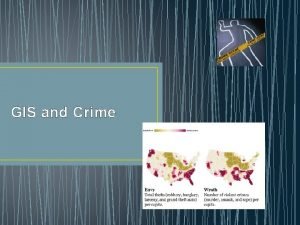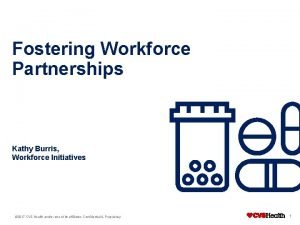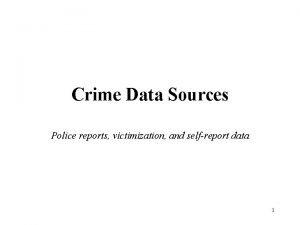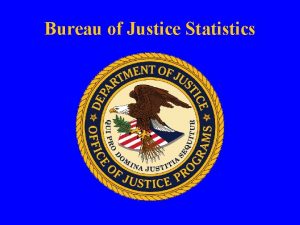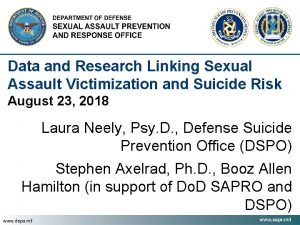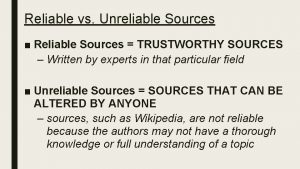Key Justice and Victimization Data Sources Kathy Au



























- Slides: 27

Key Justice and Victimization Data Sources Kathy Au. Coin Chief, Analysis Team Canadian Centre for Justice and Community Safety Statistics November, 2020 Delivering insight through data for a better Canada

Presentation Outline How to find key data tales – on line o. Uniform Crime Reporting Survey, Homicide Survey o. Integrated Criminal Courts data, Correctional Services data Justice data sets available through the Research Data Centres o. UCR, Homicide Survey , Integrated Criminal Courts Survey o. Self-reported surveys on gender based violence (NEW) 2 Delivering insight through data for a better Canada

Key Data table available online Criminal justice system as a funnel • Police data – all violations reported to the police 2, 142, 454 incidents reported to police (35 Data Tables) Courts data only those offenders that have been arrested and charged Cases with guilty findings in Adult Criminal Court 220, 233 and where there is sufficient evidence to proceed. (25 Data tables) Admissions to P/T Custody 62, 771 Corrections data – reflects information on those that were found guilty (15 Data Tables) 4, 809 Admissions to federal Jurisdictions 3 Delivering insight through data for a better Canada

Police Administrative Records Uniform Crime Reporting Survey – RDC Files • Measures the incidence of police reported crime in Canada • Close to 100% coverage, national, provincial, CMA and non CMA • UCR generates micro data for the purposes of examining characteristics of victims, accused and incidents • Captures data on more than 200 Criminal Code offences • Violent crime : violations causing death, sexual & physical assault, robbery, extortion • Property crime: arson, break & enter, shoplifting, mischief 4 Delivering insight through data for a better Canada

Police Administrative Records Uniform Crime Reporting Survey Other Crimes • impaired driving • prostitution, possession of weapons, counterfeiting • violations resulting in the deprivation of freedom Drug Related Crime • possession, trafficking, importation, production • cannabis, heroin, cocaine 5 Delivering insight through data for a better Canada

Police Administrative Records Uniform Crime Reporting Survey • UCR Incident-based survey has 3 main files o accused file o victim file o incident file • Each file can be used independently or they can be linked – depending on the research question (unit of count, number of victims/offenders/crimes) • Significant number of records • Police boundary files – contextual data, population files 6 Delivering insight through data for a better Canada

Incident UCR file variables included on the RDC file location of incident school, institution, private dwelling, open area, streets time and date of incident – temporal analysis occupancy to determine if the victim and accused were living together Geography National, province/territory, CMA and Non CMA Most Serious Weapon present 7 Delivering insight through data for a better Canada

UCR Variables included in the RDC files Accused File • Age and sex • Data charge laid Victim file • Age and sex • Violation • Relationship to the accused • Injury sustained • Weapon causing injury 8 Delivering insight through data for a better Canada

UCR Variables included in the RDC files • 5 years of data increases N for analysis of violations that are small in number • Data for 2006 through to 2016 available, data for 2018 and 2019 coming soon • Files can be used individually or combined, victim, accused and incident, how to link the files included in documentation • No Trend ANALYSIS • Population data included 9 Delivering insight through data for a better Canada

Potential Research Questions • Intimate partner violence • Violence against children and youth • Youth crime, patterns and characteristics • Adult crime, patterns and characteristics • Temporal patterns of crime • Crimes involving weapons • Family versus non family victimization • Regional differences in crime patterns • Changes over time – pre and post COVID 10 Delivering insight through data for a better Canada

UCR End User Documentation • Developed from police scoring guides • Extremely detailed • User friendly • Confidentiality guidelines • Explanation of rounding vs. vetting rules • Scoring guide • Aggregations • SAS coding examples 11 Delivering insight through data for a better Canada

Homicide Variables available Same victim/accused & incident characteristics listed for UCR and the following • Indigenous for victim or offender is noted • Detailed relationships • Drugs and alcohol involved • Motivation for the homicide • Whether the victim was a missing person • History of family violence 12 Delivering insight through data for a better Canada

Homicide Survey • Development of use friendly disclosure rules to ensure confidentiality of data • Disclosure rules approach – similar to UCR • Create RDC/RTRA data file containing homicide data from 19612015 (additional years 2016 -2018 in the near future) • Outputs for 10 years data periods 13 Delivering insight through data for a better Canada

Research Questions - Homicide Survey • Family related homicides • Intimate partner homicides • Temporal analysis • Firearm related homicides • CMA and non-CMA analysis 14 Delivering insight through data for a better Canada

Integrated Criminal Courts Survey • Administrative records of cases before the courts • Provincial and Territorial Data • Variables include age, sex of individual before the courts • Count of decisions by charge • Types of decision (guilty, probation) • Sentencing patterns 15 Delivering insight through data for a better Canada

Research Questions Integrated Criminal Courts Survey • Case processing times • Elapsed time • Efficiency of the justice system 16 Delivering insight through data for a better Canada

Tracking the future of crime and community safety in Canada • The pandemic has created a unique opportunity to examine variations in crime patterns and trends across Canada as a result of restrictions on movements and stay at home orders, some have referred to this as a perfect Criminological Experiment • Information gleaned from examining changes in these patterns can inform the development of prevention, enforcement and victim service programming in support of social and economic recovery. • Data collection and analysis activities are planned to address key research questions: • How will police-reported crime and calls for service change as Canada moves through this pandemic? • How has COVID-19 affected offenders placed on conditional or early release? • Has overrepresentation of Indigenous and other vulnerable populations in corrections increased or decreased during the pandemic? • Is collecting data on pandemic related court processing delays feasible? If so, has the 1 pandemic contributed to delays? 7 • Has there been an increase in family violence as people are isolated in their homes • How have changes in employment affected crime patterns? Delivering insight through data for a better Canada

Disaggregated data – the current landscape in justice and elsewhere • Statistics Canada has been tracking and making public, socio-economic trends for vulnerable populations for some time. • While issues of systemic racism are not new to Canada, COVID-19 has raised significant concerns about the potential disproportionate socio-economic impacts on vulnerable populations, including within the justice system. • The relationship between public health and economic recovery, and where governments place emphasis and resources has brought long-standing issues of equity and fairness along with social cohesion and wellness to the forefront. • Gaps in disaggregated data for basic indicators are very real and the challenge amplified, where these data are not collected at source, not shared either at all or on a standardized and timely manner with the nation’s statistical agency. Delivering insight through data for a better Canada

Working with partners to advance disaggregated police-reported crime data A joint statement by Statistics Canada and the Canadian Association of Chiefs of Police July 15, 2020 Today, the Canadian Association of Chiefs of Police and Statistics Canada announced a commitment to work together to meet an important information need for the justice community. Together, the two organizations will work with the policing community and key organizations to enable police to report statistics on Indigenous and ethno-cultural groups in police reported crime statistics on victims and accused 1 9 persons. Delivering insight through data for a better Canada

New surveys on Gender-Based Violence All surveys are funded through Status of Women Canada’s Strategy to Prevent and Address Gender-Based Violence Gender-based violence is defined as a form of violence against someone based on their gender, gender identity or perceived gender. SSPPS and SPSPS are now available in the RDC and SSMW will be available next year Delivering insight through data for a better Canada 20

How was the SSPPS information collected? Sample § Almost 46, 000 respondents § Response rate of 44% § Target population: Canadians 15 years of age and older, living in the provinces or territories § Residents of institutions are excluded Modes of collection § Self-response (online) § Telephone interviews § In-person interviews and online (North only) Collection period § Provinces: April to December, 2018 § Territories: September to December, 2018 General Social Survey (GSS) Victimization final sample just over 35, 000 Delivering insight through data for a better Canada 21

SSPPS—General population survey core themes § Perceptions of gender roles and gender-based violence § Inappropriate sexual behaviors observed and experienced • In a public space and details on the most serious behaviour experienced • Online and details on the most serious behaviour experienced • In the workplace Experiences of violent victimization § • Physical assault, sexual assault, stalking • Past 12 months and lifetime experiences Experiences of abusive and violent behaviours in intimate partner relationships § • Lifetime experiences • Past 12 months • Range of abusive intimate partner violence expanded Delivering insight through data for a better Canada 22

§ § SSPPS—Key national indicators feeding into the Genderbased Violence Strategy New national indicators • Lifetime prevalence of physical assault, sexual assault, and intimate partner violence • A measure of intimate partner violence which includes dating partners • A measure of Canadians’ perceptions relating to gender roles, gender equality, and gendered violence Data which can supplement information already available • Prevalence of physical assault and sexual assault in the past 12 months • Information on inappropriate sexual behaviour experienced online and in the workplace in the past 12 months • Details about physical assault, sexual assault, and intimate partner violence • Increased sample size will allow for more detailed analysis of populations of interest Delivering insight through data for a better Canada 23

GSS on Victimization SSPPS Intimate partner violence Violence or abuse committed by a current or former spouse, common-law partner, or dating partner § Life time and past 12 months § 27 behaviours—prevalence and frequency (past 12 months) Violence or abuse committed by a current spouse or common-law partner, or a former spouse or common-law partner with whom the respondent has had contact in the past 5 years § Past 5 years and past 12 months § 21 behaviours—prevalence (past 5 years and past 12 months) Reporting to police Differences between SSPPSReporting and GSS to police § Focuses on the experience of the respondent § when dealing with police: how they were treated, whether they felt comfortable, whether they felt dealing with police was worth their time and effort Important information about how the interaction between victims and police is interpreted § § § Focuses on reasons for reporting or not reporting Allows for comparisons between violent and nonviolent crime, incident details between reported and non-reported incidents Possibility of trend analysis on reporting to police 24 Delivering insight through data for a better Canada

Differences between SSPPS and GSS SSPPS GSS on Victimization Core content § § § Inappropriate sexual behaviours Physical and sexual assault Intimate partner violence § § § Measures: § § § Experiences of criminal victimization Spousal violence Violent and non-violent crime Range of inappropriate behaviours—many of which do not meet criminal threshold Experience of the respondent when dealing with police: how they were treated, whether they felt comfortable, whether they felt dealing with police was worth their time and effort How the interaction between victims and police is interpreted Perceptions of gender roles and gender-based violence Lifetime experiences § § 9 types of crime—violent (physical and sexual assault, robbery) and non-violent crimes Perceptions of personal safety and crime Perceptions of police, courts, and the criminal justice system Trends in reporting criminal victimization to police 25 Delivering insight through data for a better Canada

Survey themes focusing on post secondary student experiences § § Inappropriate sexual and discriminatory behaviours, observed and experienced • Inappropriate verbal or non-verbal sexual communication • Sexually explicit materials • Physical contact of a sexual nature • Discrimination on the basis of sex, gender identity, or sexual orientation Sexual assault • Three standard measures and new measure on ‘stealthing’ (e. g. , non-consensual condom removal) § Characteristics and actions taken § Additional information: • Attitudes about post-secondary institutions in relation to sexual violence • General knowledge and attitudes about inappropriate behaviours and sexual assault • Feelings of personal safety 26 Delivering insight through data for a better Canada

Questions? 27 Delivering insight through data for a better Canada
 Compliant victimization
Compliant victimization Nature of victimization
Nature of victimization Victim proneness
Victim proneness Victimization theory
Victimization theory Uses of gis in crime prevention
Uses of gis in crime prevention Print sources of information
Print sources of information Water resources importance
Water resources importance Data collection secondary data sources
Data collection secondary data sources Cost structure example business model canvas
Cost structure example business model canvas Key partners key activities key resources
Key partners key activities key resources Ruth and tommy relationship
Ruth and tommy relationship Isagenix rank structure
Isagenix rank structure National archive of criminal justice data
National archive of criminal justice data Data analysis in criminal justice
Data analysis in criminal justice Dr kathy weston
Dr kathy weston Kathy spruiell
Kathy spruiell Kathy jett
Kathy jett Kathy cooksey
Kathy cooksey Kathy zilch
Kathy zilch Kathy burris
Kathy burris Fig. 2
Fig. 2 Kathy shum
Kathy shum Kathy whitmire
Kathy whitmire Lstatus
Lstatus Kathy gamboa
Kathy gamboa Kathy wonderly
Kathy wonderly Iatul
Iatul Kathy kubo
Kathy kubo




